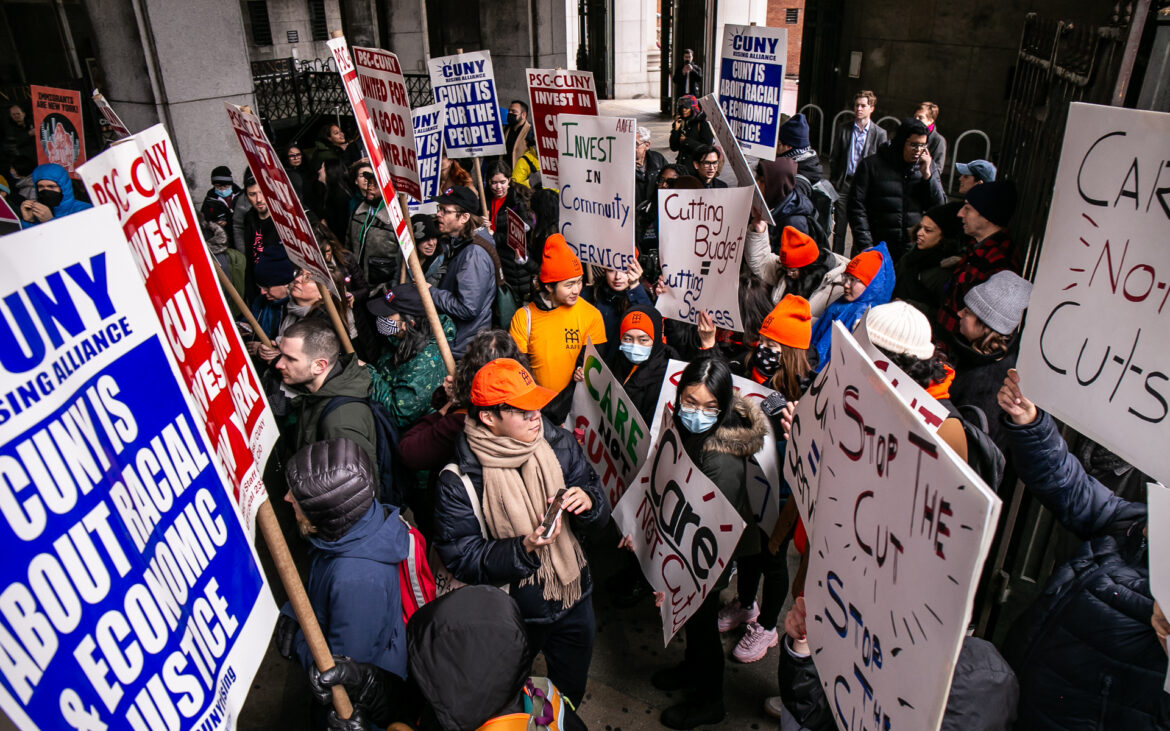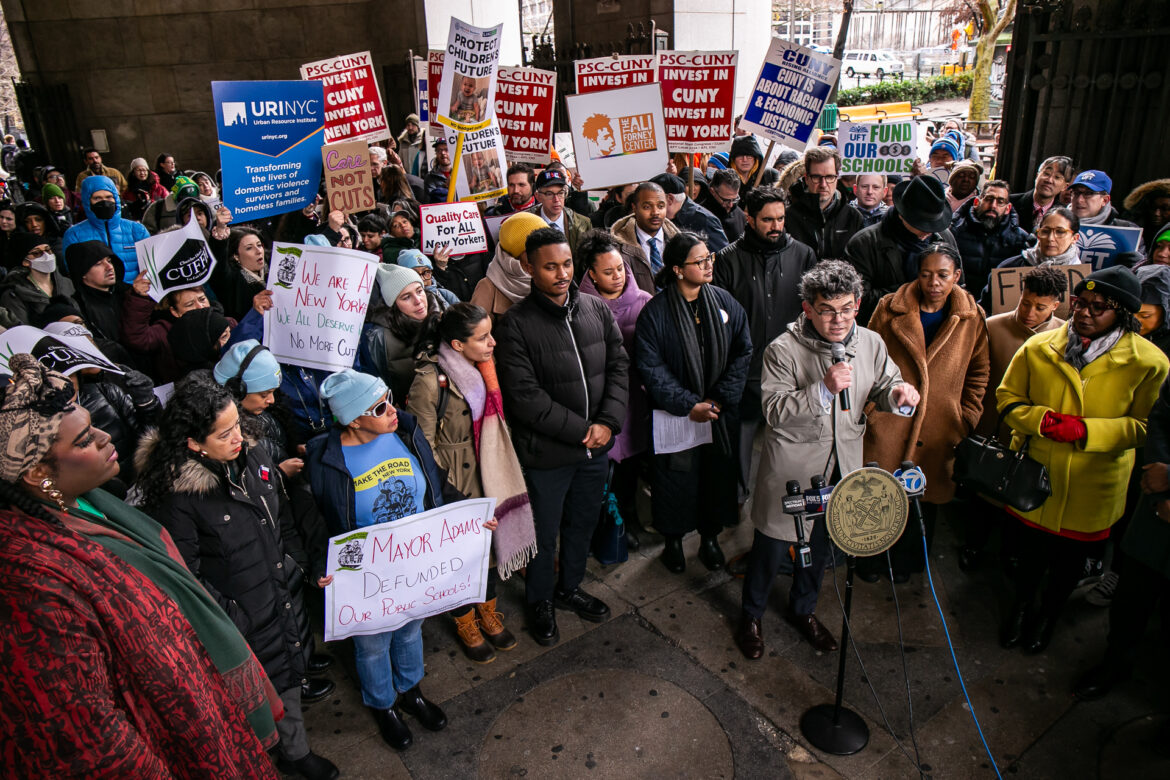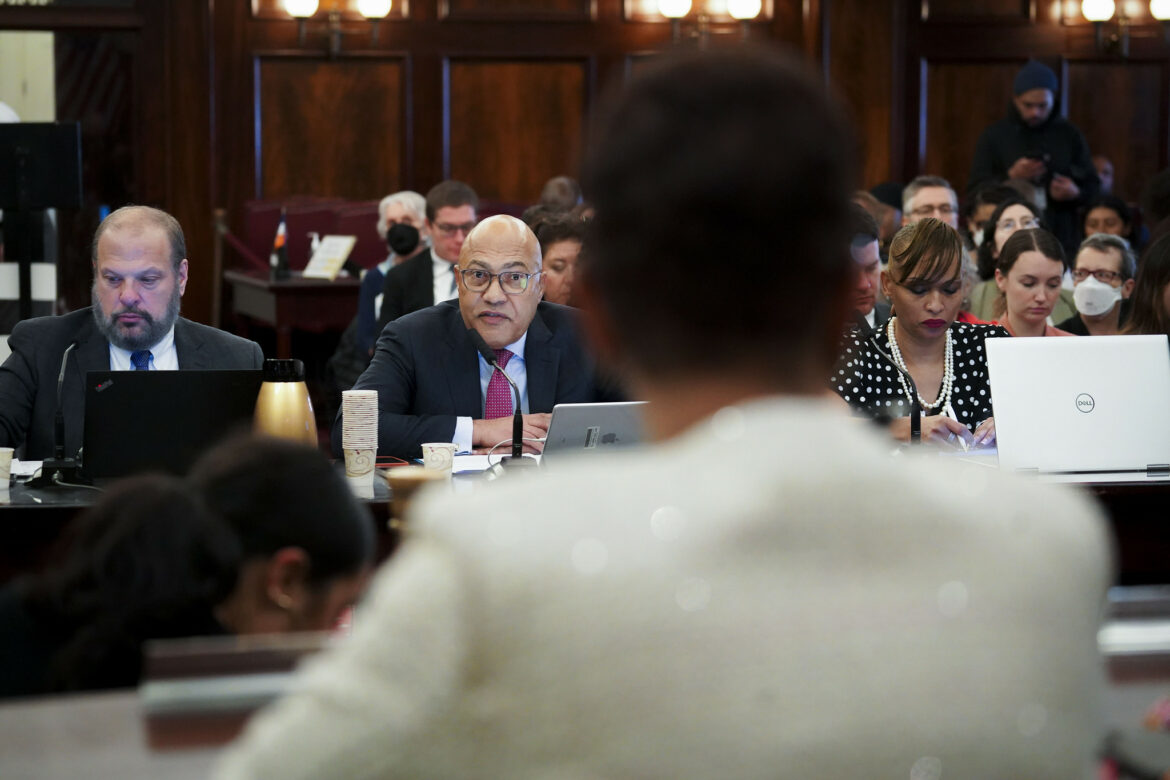While New York City must propose a balanced budget in January for the coming fiscal year, some say Adams’ approach to closing the gap—multiple rounds of budget cuts across most agencies—is a blunt instrument, and not the only option.

Adi Talwar
Members of the NYC Council’s Progressive Caucus and their allies rallied Monday at 1 Center Street in Downtown Manhattan in opposition to Mayor Adams’ budget cuts.
Fresh off a 5 percent cut to city spending finalized in November—and with two more rounds looming for January and April—analysts and immigrant advocates are scrutinizing Mayor Eric Adams’ approach to balancing budgets.
The mayor has said multiple Programs to Eliminate the Gap, or PEGs, are necessary due to the high cost of sheltering an influx of immigrants to New York City since early 2022, in addition to expiring federal aid tied to the coronavirus pandemic and recent, larger-than-anticipated union contracts.
“The biggest part of this is dealing with the asylum seekers that our city is facing,” Adams told reporters on Nov. 28. “And I’m going to continue to raise my voice and state that New York does not deserve this.”
A few months prior, the Office of Management and Budget (OMB) dramatically revised its projected cost of caring for this population: from $2.9 billion to $4.7 billion for the year ending next June, and from $1 billion to $6.1 billion in the following year, Fiscal Year 2025.
Adams has repeatedly called for state and federal support to help cover these costs, and has been disappointed with contributions so far. Outside funding, primarily from the state, is less than a quarter of Adams’ projected asylum seeker cost for this year as of November, according to the Independent Budget Office (IBO).
In response, OMB recently announced that agencies must reduce migrant spending by 20 percent by January.
But critics say that although the cost of sheltering and aiding immigrant families is undoubtedly large, it is also difficult to predict. Recent changes, from temporary status for Venezuelans to Comptroller Brad Lander’s withdrawal of certain emergency contracting powers, could translate into lower-than-projected costs.
And while New York City must, by law, propose a balanced budget in January for the coming fiscal year, some say Adams’ approach to closing gaps—multiple rounds of budget cuts across most agencies, this year and last—is a blunt instrument, and not the only option.
“His one move is to cut,” Brooklyn Council Member Lincoln Restler said Monday, at a rally hosted by the City Council’s Progressive Caucus ahead of the body’s November budget update hearing. The assembled crowd condemned planned reductions to services like composting and library hours. “It’s to cut, it’s to cut, and it’s to cut again.”

Adi Talwar
“His one move is to cut,” Brooklyn Council Member Lincoln Restler, at mic, said Monday during a rally against the mayor’s budget plan.Caring for recently-arrived immigrants in New York City cost $1.47 billion over the fiscal year that ended in June, according to the IBO.
To reach its revised projections for this year and next, OMB assumed net growth of 55 immigrant households per day through June 2024. They took the midpoint between the typical growth from October to April and a July spike, and reduced it by 20 percent to account for new policies aimed at reducing the census, like 60-day shelter stay limits.
This projection landed the city at 44,000 households in shelter by the end of June 2024, a population OMB predicts will hold steady through June 2025. Throughout, OMB assumes a nightly per-household cost of $383—the cost as of August, which exceeded the average nightly cost of $320 assumed in this year’s June adopted budget.
This month, OMB projected a gap of $7.1 billion in Fiscal Year 2025—driven by $6.1 billion in assumed immigrant costs.
But estimates vary from one budget watcher to the next, both in the overall size of gaps in the coming years, and how much is attributable to asylum seekers.
In October, for example, Lander’s office estimated a larger gap of $9.65 billion next year, assuming a smaller asylum seeker cost of $3.65 billion but factoring in other financial risks, like the cost of uniformed agency overtime and Carter cases, lawsuits that the city pays out to cover private school for children with special needs.
While recent immigrant costs are real and worthy of attention, Lander told City Limits, they have dominated the narrative in recent weeks in a way that is dangerous, generating “animosity and hostility at a very anxious time.”
City Hall also tends to be cautious in its revenue projections. Over the weekend, the City Council released a revised financial forecast for the year, predicting $1.2 billion more in tax revenue than OMB did in May, its most recent forecast.
The IBO predicted lower asylum seeker costs for next fiscal year in its own analysis released Monday—$2.4 billion on the low end and $3.9 billion on the high end—projecting that the census will decline over the year that starts in July rather than hold steady and testing two per diem shelter costs: $320 and $394.
Testifying before the Council Monday, OMB Director Jaques Jiha said his office saw no reason to adjust projections in November, and will revisit them in January, alongside an updated financial forecast, which is used to predict tax revenues. OMB may also tap into $1.45 billion in city reserves come January, he said, but did not specify how much.

Gerardo Romo / NYC Council Media Unit
Jacques Jiha and other members of the Mayor’s Office of Management and Budget testifying before the City Council Monday.
Finance Committee Chair Justin Brannan asked Jiha if he might be putting the cart before the horse. “How can the public properly assess if the city needs to make these budget cuts when OMB is relying on tax revenue projections that are essentially eight months old?” he asked.
Reserves and revenue re-estimates will not close the entire gap, Jiha said, adding: “Our goal has always been to try to frontload the solution of the problem, so that we’re not leaving anything to chance.”
But some budget watchers say the city can and should get creative to preserve the services that New Yorkers rely on.
For example, the city could propose a balanced budget next month by tapping reserves and anticipating further state funds, on top of higher-than-projected revenues, according to the Fiscal Policy Institute.
“The asylum seeker costs really are unprecedented, and there’s a lot of uncertainty around them,” said Senior Policy Analyst Andrew Perry. “Our main takeaway is, let’s not overreact.”
The Citizens Budget Commission (CBC) is more fiscally cautious, and warned Monday against using reserves, saying they should be saved for recessions. But while the organization is generally supportive of Adams’ PEGs, it stressed that the city must carefully analyze which cuts will do the least harm.
According to CBC’s analysis, immediate service cuts have been a small part of recent PEGs, which agencies also achieve by re-estimating costs and eliminating vacant positions. But November’s PEG had a larger share of service cuts than Adams’ previous rounds, according to CBC’s analysis—around 20 percent.
Ana Champeny, vice president for research at CBC, called for a “strategic approach… to ensure that a budget axe is not swung blindly” in her testimony for the Council hearing.
George Sweeting, a senior fellow at the Center for New York City Affairs at New York University and an IBO veteran, recalled instances of serious financial strain in the city, including in the wake of the Sept. 11 terror attack and the Great Recession of 2008.
As of November, OMB’s projected budget gap for the coming fiscal year is 9 percent of city funded revenue, large compared to recent history but on par with the projected outlook in November 2009, according to an analysis by State Comptroller Tom DiNapoli.
Historically, Sweeting told City Limits ahead of Monday’s hearing, large budget gaps have been closed with a combination of PEGs and tax increases. New York City sets property taxes, while other taxes are set by the state.
“Given the magnitude of the gaps, you would wind up with some pretty significant service reductions if you did it all through budget cuts,” he said.
Lander’s office has already called for tax increases to raise revenues and take some pressure off the city budget.
“The state is in a strong position to raise revenues on the wealthiest New Yorkers in a fair and progressive way that really targets people whose wealth has grown dramatically from the pandemic,” he told City Limits.
Gov. Kathy Hochul has been explicit, so far, that she won’t. “I’m not raising taxes in our budget this year,” she told reporters on Nov. 20. “Taxes are high enough in the State of New York and we have to live within our means.”
But the mayor could use his bully pulpit to “add urgency to the fight” if he so chose, said Queens Assemblymember Zohran Mamdani, who attended Monday’s rally against cuts. Instead, he said, Adams has used the pulpit to “fear monger,” like when he warned in September that a migrant crisis would “destroy New York.”

Adi Talwar
Attendees at a rally Monday in Lower Manhattan protesting the mayor’s cuts.If the city moves ahead with a 20 percent cut this January in spending to support recently arrived immigrants, it must be strategic, advocates said, reigning in emergency services contracts issued to for-profit companies.
“It’s not just what they are spending, but how they are spending it is extremely perplexing,” Murad Awawdeh, executive director of the New York Immigration Coalition, told City Limits.
Jiha testified Monday that OMB’s goal is to both reduce per diem costs and shrink the migrant census in city care—through strategies like shelter-stay limits, after which adults and, soon, families, must reapply. One strategy the city is exploring, Jiha said, would entail shifting contracts for operating small emergency shelters to nonprofits.
Of the $383 per night per immigrant household used in OMB’s August cost projections, 38 percent is attributed to shelter. Another 37 percent is services and supplies—a broad category including everything from case management to laundry and legal aid—plus 10 percent or less for information technology, medical and food, respectively.
Though the breakdown is not precise when it comes to legal services, advocates say this is one area where the city should not cut spending. Already, they are struggling to keep up with demand from immigrants with complex cases, including those who have lost their asylum bids and are now facing deportation.
Yet the Rapid Response Legal Collective, which provides immigration legal services, was one of the entities hit with a funding cut—of $306,000—in Mayor Adams’ latest PEG, City Limits recently reported.
The city’s approach is making it difficult for immigrant families to get situated in New York City, and, ultimately, contribute to the economy, said Camille Mackler, executive director of Immigrant ARC, a coalition of New York legal service providers.
“We have some community organizations that see 500 people a week—some of them in shelter, some of them not,” she said. “They don’t know where to go, they still need assistance, and they’re still going to be using city services in different ways.”
To reach the reporter behind this story, contact Emma@citylimits.org. To reach the editor, contact Jeanmarie@citylimits.org








